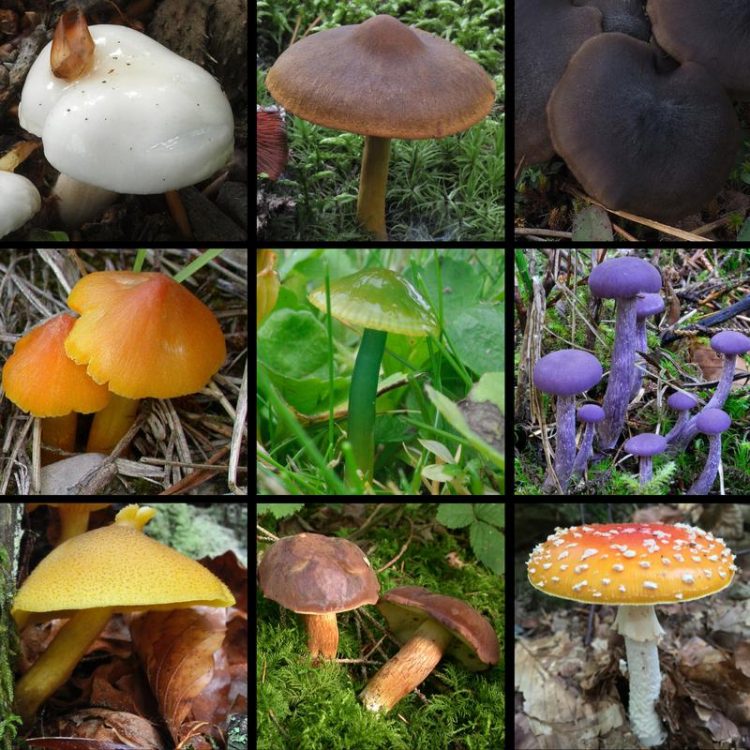The secret of mushroom colors

Über 3000 Pilzarten wurden im Rahmen der Untersuchung analysiert, darunter: Elfenbeinschneckling (1. Reihe v.l.), Blutblättriger Hautkopf, Dunkler Rasenrötling, Safrangelber Saftling (2. Reihe v.l.), Papageiensaftling, Violetter Lacktrichterling, Olivgelber Holzritterling (3. Reihe v.l.), Maronen-Röhrling, Fliegenpilz. Bild: Franz Krah, Peter Karasch/Nationalpark Bayerischer Wald
The fly agaric with its red hat is perhaps the most evocative of the diverse and variously colored mushroom species. Hitherto, the purpose of these colors was shrouded in mystery.
Researchers at the Technical University of Munich (TUM), in collaboration with the Bavarian Forest National Park, have now put together the first pieces of this puzzle.
In nature, specific colors and patterns normally serve a purpose: The eye-catching patterns of the fire salamander convey to its enemies that it is poisonous. Red cherries presumably attract birds that eat them and thus disperse their seed.
Other animals such as chameleons use camouflage coloring to protect themselves from discovery by predators.
But climate also plays a role in coloration: Especially insects and reptiles tend to be darker in colder climates. Cold-blooded animals rely on the ambient temperature to regulate their body temperature. Dark coloration allows them to absorb heat faster.
The same mechanism could also play a role in fungi, as the research team of Franz Krah, who wrote his doctoral thesis on the topic at TUM and Dr. Claus Bässler, mycologist at the TUM and coworker in the Bavarian Forest National Park suspect. Mushrooms might benefit from solar energy to improve their reproduction, as well.
Distribution of 3054 fungus species studied
To test their theory, the researchers combed through vast volumes of data. They investigated the distribution of 3054 species of fungi throughout Europe. In the process, they analyzed the lightness of their coloration and the prevailing climatic conditions in the respective habitats. The results showed a clear correlation: Fungal communities have darker mushrooms in cold climates. The scientists also accounted for seasonal changes. They discovered that fungal communities that decompose dead plant constituents are darker in spring and autumn than in summer.
“Of course, this is just the beginning,” explains Krah. “It will take much more research before we develop a comprehensive understanding of mushroom colors.” For example, further seasonal coloring effects cannot be detected in fungi that live in symbiosis with trees. “Here, other coloration functions, such as camouflage, also play a role.” The researchers also need to study the degree to which dark coloration influences the reproductive rate of fungi.
Publications:
Franz-Sebastian Krah et al., Nature Communications Volumes 10, Article Number: 2890 (2019) “European mushroom assemblages are darker in cold climates.”
www.nature.com/articles/s41467-019-10767-z
Contacts to this article:
Technical University of Munich
Plant Biodiversity Research Group
Dr. Franz Krah
franz.krah(at)tum.de
Prof. Hanno Schaefer
Tel: 0816171-5884
hanno.schaefer(at)tum.de
Media Contact
All latest news from the category: Life Sciences and Chemistry
Articles and reports from the Life Sciences and chemistry area deal with applied and basic research into modern biology, chemistry and human medicine.
Valuable information can be found on a range of life sciences fields including bacteriology, biochemistry, bionics, bioinformatics, biophysics, biotechnology, genetics, geobotany, human biology, marine biology, microbiology, molecular biology, cellular biology, zoology, bioinorganic chemistry, microchemistry and environmental chemistry.
Newest articles

High-energy-density aqueous battery based on halogen multi-electron transfer
Traditional non-aqueous lithium-ion batteries have a high energy density, but their safety is compromised due to the flammable organic electrolytes they utilize. Aqueous batteries use water as the solvent for…

First-ever combined heart pump and pig kidney transplant
…gives new hope to patient with terminal illness. Surgeons at NYU Langone Health performed the first-ever combined mechanical heart pump and gene-edited pig kidney transplant surgery in a 54-year-old woman…

Biophysics: Testing how well biomarkers work
LMU researchers have developed a method to determine how reliably target proteins can be labeled using super-resolution fluorescence microscopy. Modern microscopy techniques make it possible to examine the inner workings…





















